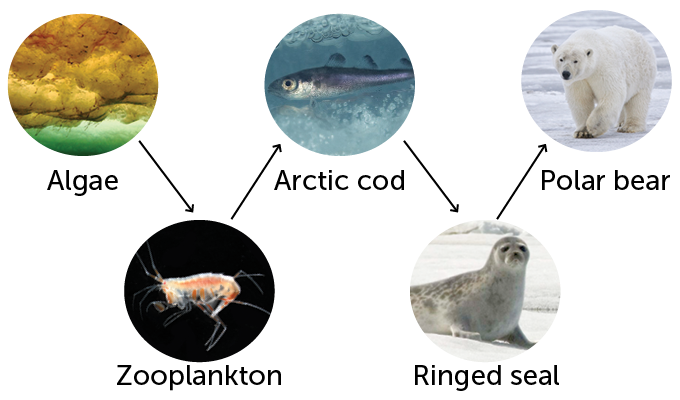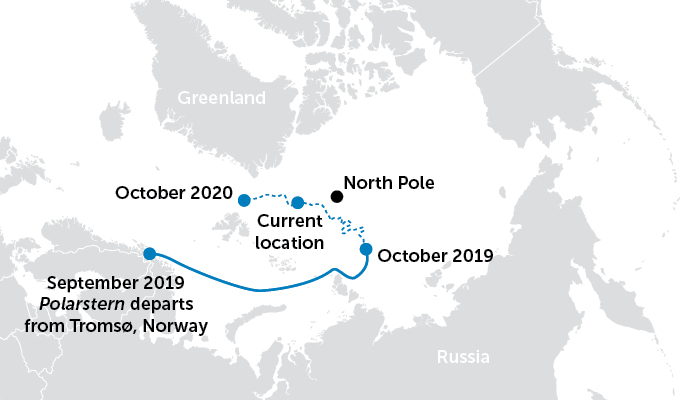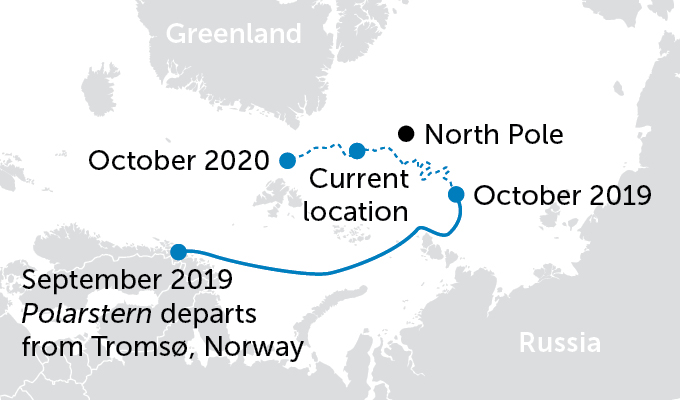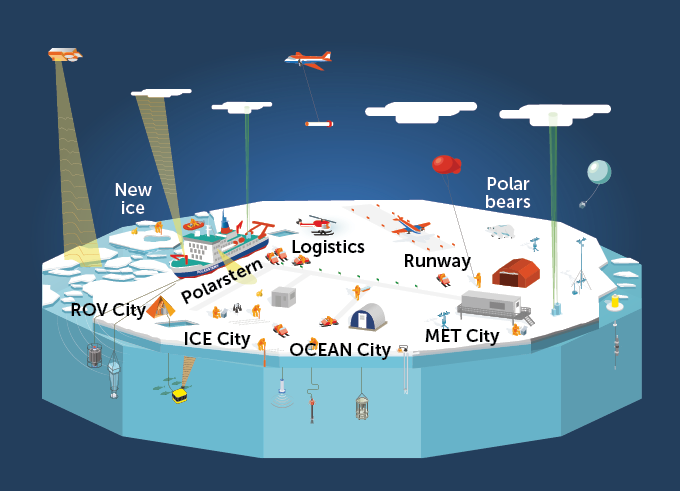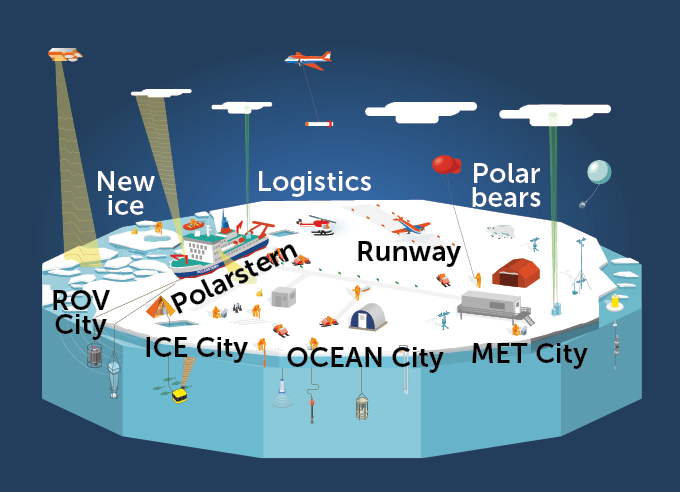A year long expedition spotlights night life in the Arctic winter
In a ship deliberately embedded in an ice floe, scientists are studying the base of the food web

MOSAiC scientists look at an ice block on their temporary ice floe home on October 23, 2019.
Esther Horvath
Allison Fong dangles over the edge of a “river” running through a massive chunk of sea ice floating between the North Pole and Russia’s Komsomolets Island. The river cracked open in the ice just a few days ago, exposing the Arctic Ocean below. Already starting to freeze over, the river’s surface is a dark scar in the white landscape.
The crack could open further, destabilizing or even cleaving the 3-kilometer-wide floe. To avoid falling into the hypothermia-inducing waters (which hover at –1.8° Celsius), Fong distributes her weight on her hands and knees and is tethered to a stronger piece of ice a few meters away.
She looks at ease as she pulls a chunk of recently frozen ice from the crack and squeezes it slightly. It seems solid, but it compresses like a cube of Jell-O, which means the chunk hasn’t completely frozen and still contains small chambers of liquid water. Those chambers are home to microscopic organisms that will remain trapped in the ice throughout winter — enduring pitch-black days and frigid temperatures from October until March, when the sun finally returns.
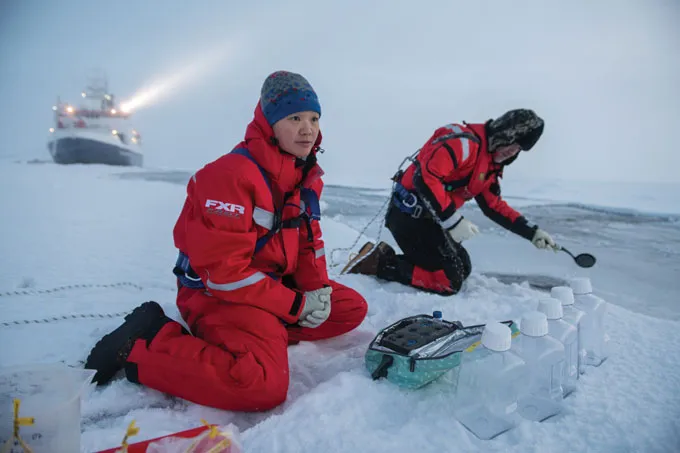
And yet those organisms manage to thrive. Fong, a biologist with the Alfred Wegener Institute in Bremerhaven, Germany, wants to know how.
Even phytoplankton, a type of algae that relies on sunlight to fuel photosynthesis, are far from dormant in the dark. Scientists suspect that these microscopic creatures rely on stored deposits of fats or feed on small particles in the winter waters.
Finding out for sure is important given that these algae form the foundation of the Arctic food web. Their massive springtime blooms provide a buffet for other critters, particularly zooplankton, tiny sea animals that are munched on by larger squid and fish, which are dinner for the seals that are eaten by whales and polar bears.
Any change to the algae will surely rock the food web — and change is brewing. Rising temperatures in the Arctic have caused the ice to melt and thin. As a result, algal blooms are growing earlier in the season and farther north. Blooms have even been seen under the ice itself. To better predict these changes and how they might affect the food web, scientists first have to grasp how algae and other microscopic organisms survive polar night and how they respond to the lowest levels of light.
Much about the Arctic remains a mystery. There are more than 1,000 species of microalgae in the frigid waters, and none have been studied close to the North Pole. “There’s literally no data about animals and their activities during polar night from the central Arctic,” Fong says.
That’s because every winter, the central Arctic becomes a fortress of sea ice too thick for ships to penetrate. Most research vessels flee south. But in early October, the German icebreaker Polarstern ventured north and steered into a massive ice floe at 85° N latitude. There, the captain killed the ship’s engines, so the vessel could freeze in place.
The mission, known as MOSAiC, for Multidisciplinary drifting Observatory for the Study of Arctic Climate, is now traveling across the Arctic like a barnacle on that massive ice floe for one year. Fong and scientists from 20 countries have the unprecedented opportunity to gather data in the central Arctic during polar night to learn how climate change is affecting the vast landscape and its inhabitants — from the tiniest algae to the 900-pound polar bears.
A frozen metropolis
In mid-September, a team of MOSAiC scientists — plus a few lucky journalists including myself — set sail from Tromsø, Norway, and headed east along Russia’s coast before veering toward the North Pole. As we edged north, the days grew shorter. Soon, the sun would disappear altogether, as did any signs of other ships and birds. In every direction, the light gray sky collided with dark blue waves — and nothing else. The world seemed empty of life.
Then one night after the sun had set, I stood at the ship’s stern watching the waves in our path when I saw what looked like a shooting star in the water. The light disappeared as quickly as it had appeared. Then another flashed. And another. For several nights, the lights danced and sparkled as bioluminescent organisms (probably a type of marine plankton) produced light within the wake.
For me, it was the first hint that the seemingly dead landscape was thriving with microbial life. But it wasn’t the last. When we entered the edge of the Arctic ice cap — a mosaic of ice floes that jostle at the top of the world — I would often watch as the icebreaker crashed through sheets of white ice. Large, overturned chunks would rock the ship — often with such power that it felt as though we had run aground — and then scrape against the steel hull with a whine like nails across a chalkboard. Those chunks occasionally revealed hidden layers of turquoise ice. And every so often, the ice would be yellowish brown — a sign of ice algae.
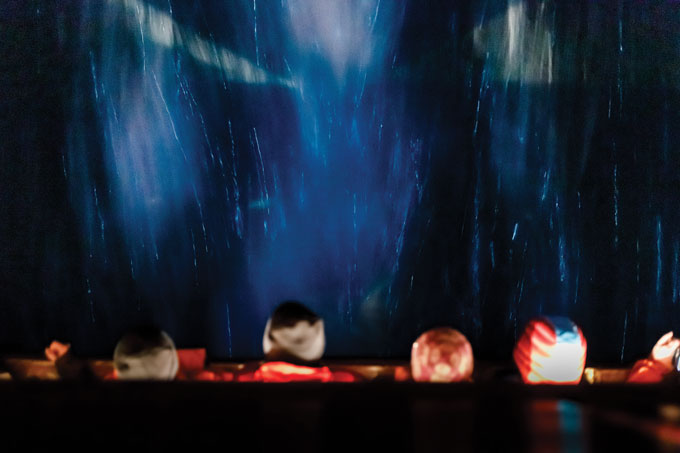
The sight of that “dirty ice” sent the scientists into a state of euphoria, eager to take a closer look at the very organisms they were there to study. Luckily, the group didn’t have to wait long. On October 4, we crashed into the ice floe that would serve as MOSAiC’s home for the next year, and scientists immediately spread out onto the ice. In a race to set up research stations before the sun set over our latitude one last time until March, teams leveled roads, set up power lines and moved instruments onto the ice.
The work was often waylaid by the challenging environment — and a furry visitor or two. Six days after the scientists began their work, a curious polar bear and her cub ambled into the camp, knocking down power lines and munching on instruments. With each subsequent visit, the ship’s horn and a radio announcement sent scientists back to the ship, halting all work on the ice.
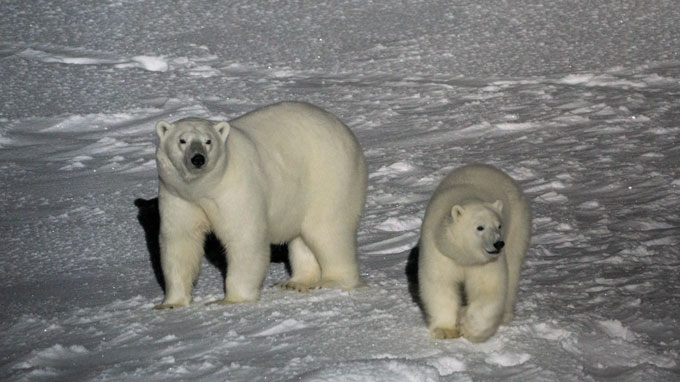
But the furry visitors weren’t the only obstacle. Ships that were sent to the ice floe every few months were often delayed by weather, and air missions were grounded in March to keep the coronavirus off the ship.
The ice didn’t always cooperate either. A few days after we reached our new home, a storm rocked the floe, opening several cracks beyond the ship’s bow. Until then, the floe had felt so stable — even continent-like — that it was easy to forget that it was just a thin veneer of ice that could be tossed about by the wind. Unfortunately for Fong, the location beyond the ship’s bow, the spot she had been eyeing for her research station, became unattainable.
Unlike other scientists who set up camp within a few hundred meters of the ship, Fong needed to work far from the ship’s bright lights to study how the Arctic’s natural light (or lack thereof) affects the tiniest critters. Once the storm dashed her initial plan, it took a few weeks for her to find a new location, more than a kilometer from the ship’s starboard side.
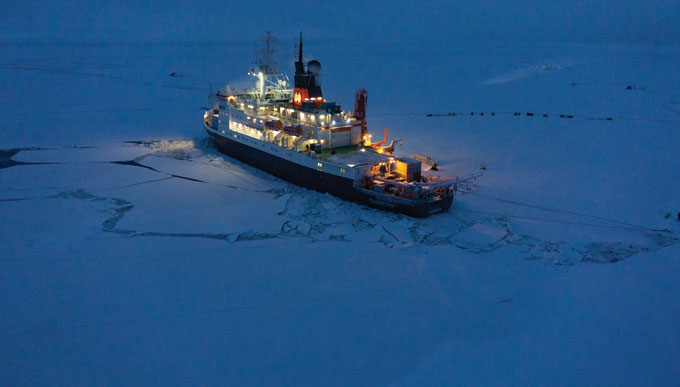
Shortly after I departed the expedition aboard a second icebreaker, Fong’s team — 10 scientists and two polar bear guards — piled into four snowmobiles and six wood sleds once a week. The group cruised along a bumpy road, past small mountains of snow and ice dubbed “the fortress,” to the other edge of the ice floe. There, in the dark, the team collected cores of ice for analysis in a dark and cold lab back on the ship. “That will give us a sense of who’s there,” Fong says, and how active those organisms might be — in the absence of light.
Dark secrets
In 2007, Jørgen Berge, a marine biologist at the Arctic University of Norway in Tromsø, was analyzing data from an instrument that had been moored to the seafloor in the low Arctic, when he noticed that masses of zooplankton had been migrating up and down the water column in winter. That behavior is typical during much of the year when daylight is in play. The creatures rise to the surface at night to feed on phytoplankton and dive back down during the day. Seeing such activity in the dark of Arctic winter, Berge thought he’d found an error in the data. But later research suggested that the zooplankton’s movement was driven by the moon’s faint light (SN: 7/6/19 & 7/20/19, p. 32).
Just because we perceive the Arctic as pitch-black during winter, other species might not. “No matter where you look, whether it’s in the marine environment or the terrestrial environment, organisms have different ways of experiencing the world and sensing the world,” says marine biologist Jonathan Cohen of the University of Delaware in Lewes.
On two Arctic cruises in 2014 and 2015, Cohen and colleagues measured what little light was available during polar night. The levels, they found, were 100 million times lower than those observed during Arctic summer. But even during the perpetual night of the Arctic winter, there is still a difference between day and night. Sunlight reflected from below the horizon actually makes the day a little brighter than the night. Plus, the moon and possibly the northern lights add a measurable glare. Still, Cohen wasn’t sure if that minimal light was enough for Arctic animals to use.
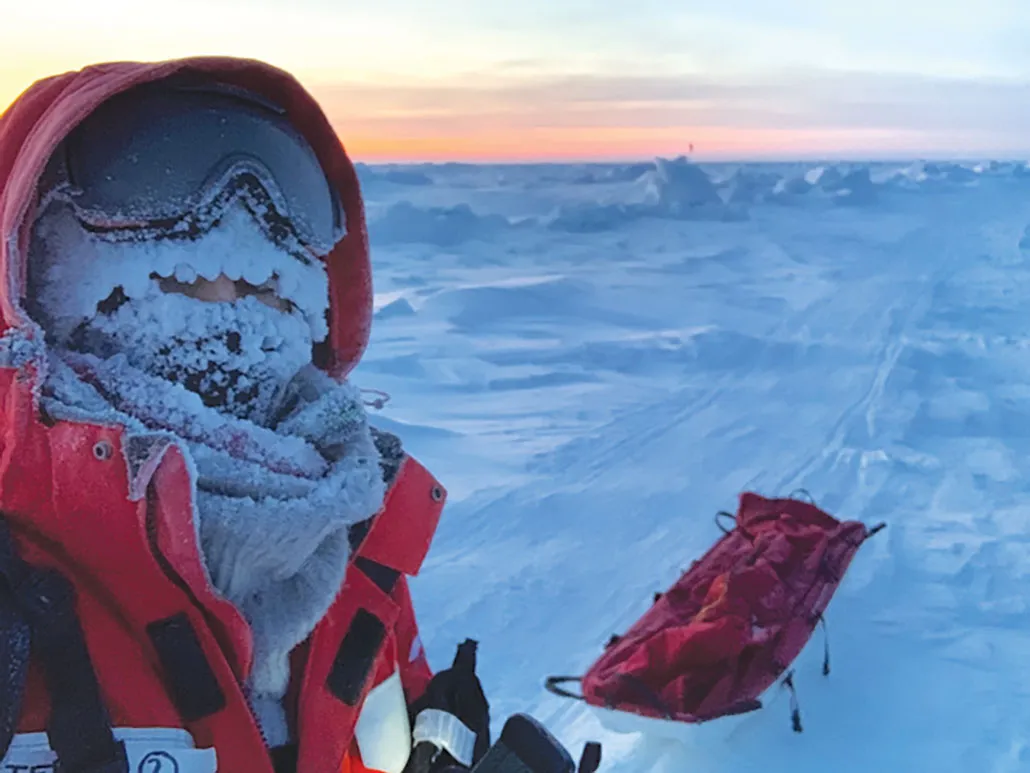
So his team hooked electrodes up to zooplankton to measure how the creatures responded to flashes of faint light. The animals reacted most strongly to the bluish colors that penetrated deep into the water column, which explains how zooplankton migrate throughout polar winter.
And those swimmers aren’t alone. Scientists have begun to realize that the Arctic — even during polar night — is astonishingly alive. Seabirds, which are thought to be visual predators, forage in the middle of winter. So do multiple species of fish and krill. Clams grow at similar rates in the winter as they do during the summer. And all kinds of organisms, including snails on the seafloor, reproduce despite the cold and darkness.
Even phytoplankton stay active. Although scientists can’t yet say exactly how, they suspect that some species live on stored deposits of fats, and others might undergo a dramatic metamorphosis every winter.
Micromonas pusilla, one of the most abundant species of phytoplankton, actually switches to a more animal-like lifestyle, feeding on bacteria and other small particles in the water column. Yet the phytoplankton manage to keep their photosynthetic apparatus intact throughout the dark polar night, which enables them to respond within hours to the return of sunlight in the spring.
“There’s a whole world that thrives during the darkness,” says Eva Leu, a marine biologist with Akvaplan-niva in Tromsø, a daughter company of the Norwegian Institute for Water Research. Leu helped plan biology experiments for MOSAiC.
But the studies that reveal the Arctic’s active nightlife barely scrape the surface. Many were performed in the lower Arctic at roughly 80° N, but MOSAiC floated closer to the North Pole — where winter is darker and lasts longer — than any other ship yet during Arctic winter.
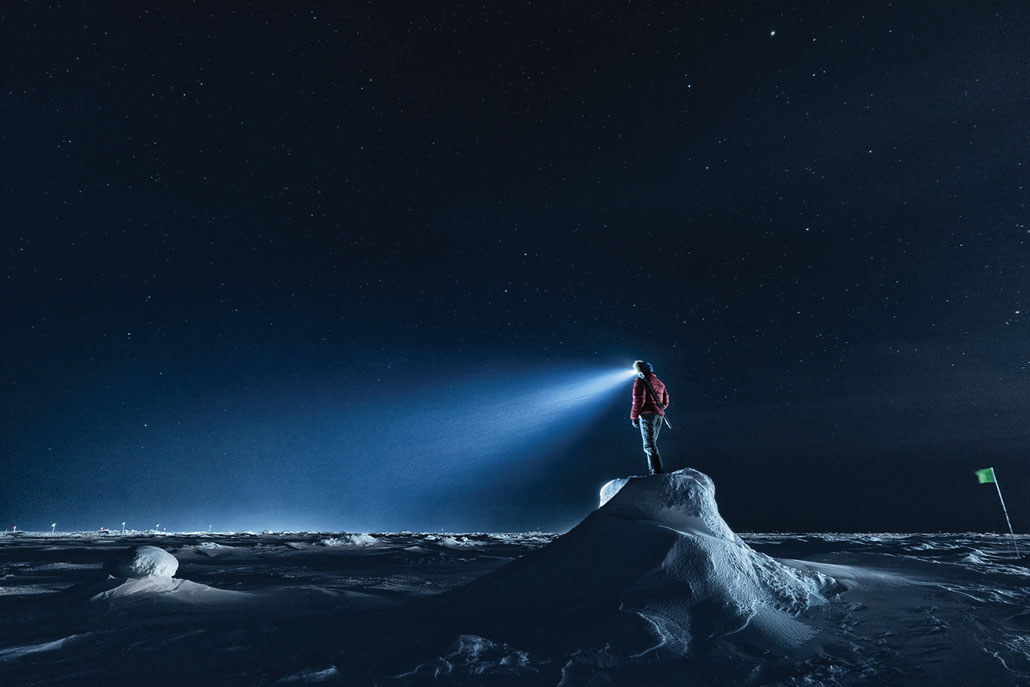
MOSAiC went north of the northern lights, to a completely different marine environment with an ocean that extends four kilometers deep (as opposed to a shallow continental shelf). As such, many of the results from past studies cannot be extrapolated to the central Arctic.
So, MOSAiC researchers will conduct physiological and genetic analyses on the life within thousands of samples in a lab onboard the ship (some will be sent to different labs for analysis). Although Fong returned to Germany in January, others kept the studies going all winter. But as the mission continues, Leu and other scientists are most eager to collect samples once another drastic change occurs in the Arctic: the return of the sun.
Spring awakening
Every spring, the sun’s rays hit the top of the world for the first time in months — creating a pink glow and warming the sea ice. Temperatures rise, the snow and ice begin to melt and life starts to flourish. Although polar night is a busier world than scientists initially imagined, it doesn’t compare to spring when phytoplankton form massive blooms that provide scrumptious meals for the rest of the Arctic food web.
Certain species of zooplankton, which spend winter at great depths, migrate to the surface in the spring to feed on the rich algal blooms. Those small animals become food for fish, eventually supporting the rest of the food web. California gray whales, barnacle geese and 135 other species of birds migrate to the top of the world to feed on the many animals that feed from the bloom. Arctic terns even travel 30,000 kilometers from the Antarctic to the Arctic. The springtime feeding frenzy is — without a doubt — the main event in the Arctic ecosystem.
“That’s the food that then carries the entire food web throughout the rest of the year,” Cohen says.
The success of this feast depends on the timing and location of the springtime blooms. “What happens during the winter months sets the stage for the coming productivity peak,” Leu says. So scientists are eager to better understand those dark months.
Knowing how different species of algae respond to low levels of light, for example, will help scientists better predict when and where those blooms might appear and even their composition.
It’s a crucial question now that the timing and location of these blooms are being altered by climate change.
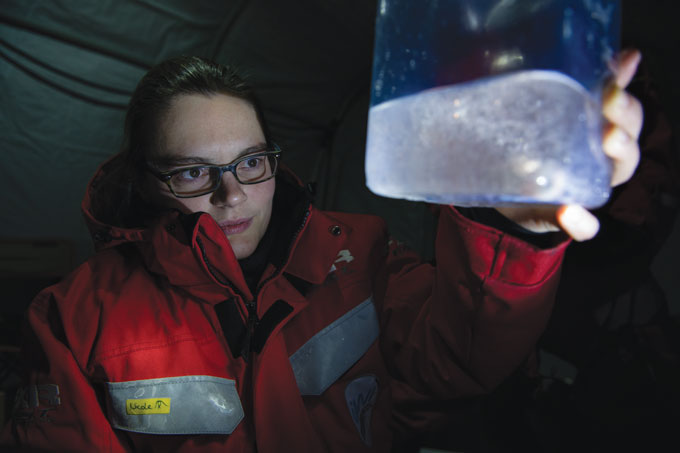
In 2011, Kevin Arrigo, a marine biologist at Stanford University, was on a research cruise between Alaska and Siberia, deep in the Chukchi Sea ice pack, when instruments submerged a few meters below the surface registered high concentrations of chlorophyll — a proxy for phytoplankton. It seemed impossible since he was surrounded by ice and snow. Both would reflect any incoming solar radiation, leaving no sunlight for plankton in the waters below. “We thought our instruments were malfunctioning,” Arrigo says. A bloom simply could not exist below the ice. But when his team drilled a hole through the thin sheet and hit the ocean below, green water flushed upward.
“It was an eye-opener,” Arrigo says. “I would have bet my life savings that there was no way you would ever find anything like this under the ice.” But only a phytoplankton bloom would have colored those waters, and it was as big as Montana.
There’s a simple explanation for this surprise finding. A stunning 95 percent of the Arctic’s oldest, thickest ice has disappeared in the last 33 years, according to the National Oceanic and Atmospheric Administration. Now, the top of the globe contains mostly young, thin ice that allows light to penetrate into the upper ocean and reach the phytoplankton below.
Since Arrigo’s 2011 study, roughly a dozen blooms have been spotted under the ice. “It’s just an absolutely amazing discovery that we never would have expected,” says Chris Horvat, a climate scientist at Brown University in Providence, R.I.
In addition, algal blooms have been spotted earlier in the season and creeping farther north — changes that will have ramifications across the Arctic. If blooms occur in a new location or at a different time, grazers, from zooplankton to Arctic terns, might miss the blooms entirely.
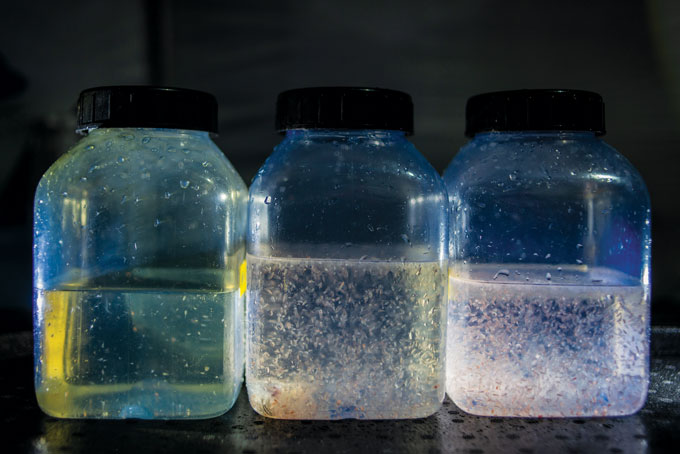
That change worries Fong. “It’s like bees and flowers,” she says. Plants bloom based on the temperature, but usually require insects for pollination. If those insects are not at a stage in their life cycle to be active pollinators, then a fruit tree that blooms too early won’t produce any fruit.
“Phytoplankton can grow and grow and grow,” Fong says. “But the only way that material gets transferred up the food web is if the primary consumers are there and able to graze upon them.”
When blooms occurred later in the season, the waters were quite warm; zooplankton reproduced and their offspring munched on phytoplankton falling through the water column. But now that blooms are occurring earlier, when the water is still colder, the zooplankton have not yet reproduced; there’s no offspring to scoop up the phytoplankton.
In this new scenario of earlier blooms, most of the phytoplankton could reach the bottom of the ocean causing the low-lying ecosystem to thrive. Gray whales, walruses and clams all feed on the bottom. But bowhead whales, Arctic cod and salmon feed in the water column — and may thus suffer the consequences if zooplankton miss their chance to dine.
Though of course much of this is speculation based on early changes. “The jury is still out on exactly what will happen,” Horvat says. MOSAiC scientists will need to complete their dark sojourn to shed light on the changing Arctic.
We summarize the week's scientific breakthroughs every Thursday.

